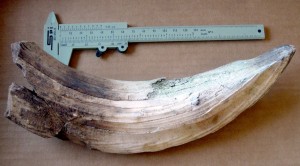Giant Beaver Tooth Found Near Marengo
Mchenry County Conservation District — February 9, 2015A Giant Beaver (Castoroides ohioensis) incisor found along an old slough in the 2,974 acre Kishwaukee Corridor near Marengo. The giant beaver became extinct approximately 13,400 years ago.
Confirmed by JJ Saunders, Ph.D. Curator and Chair of Geology Illinois State Museum and Sara Pfannkuche, archeologist and the district’s independent curator, this is only the 16th recorded find of the animal in the state of Illinois and a first in McHenry County. Another had been found previously in Garden Prairie, Boone County.
Conservation district maintenance worker Erich Parpart was on site in late December looking for old cement building foundations that may need to be removed, when he noticed something white in the brush. Growing up on a farm he knew it wasn’t a bone or horn from a cow. Staff guesses ranged from a fossilized tusk or horn from a mammoth and mastodon to possibly a saber tooth tiger.
The fossil was identified by Saunders as an incisor tooth, probably right side lower jaw, on the basis of the tooth terminating as a “gouge” exhibiting a shallow wear basin produced by occlusion with its upper mate.
“Longitudinal corrugations exhibited on/in the enamel as those on your object are quite diagnostic of giant beavers. The tusks of neither mammoth nor mastodon possess enamel beyond a small cap readily worn from the tip in very young individuals,” reported Saunders.
“The giant beaver was the largest Pleistocene rodent in North America. It was an animal the size of a black bear inhabiting lakes and ponds bordered by swamps. We know from its teeth that the giant beaver did not fell trees, and thus did not construct dams to modify stream courses. Its sheer size suggests it required large bodies of water. Since its skeleton indicates it was even more cumbersome on land than is the modern beaver, it seems to have been more restricted to these environments. In these features, giant beaver habits were more like those of muskrats than like those of the modern beaver. Characteristics include its enormous blunt-tipped, gouging suited, upper and lower incisor teeth, short legs and small front feet, presumably webbed hind feet, and a long, only moderately-widened, tail,” added Saunders.
At this time the conservation district does not have a date of when the fossilized tooth will be on display.








